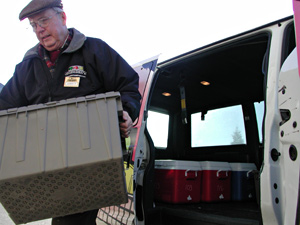|
Audio
Photos
Resources
Your Voice
|
Desktop to tabletop: the online grocery revival
January 3, 2003
 |
| John Turner retired after 10 years with St. Cloud-area Coborns stores, but returned in December to work part-time as a driver for the online shopping service. (MPR Photo/Jeff Horwich) |
St. Cloud, Minn. — John Turner works his crates and coolers up to the intercom of a south St. Cloud Apartment complex. He's buzzed in by a woman on the third floor, and moves the boxes through two entryway doors, into the elevator.
One month ago, the retired grocery store manager went back to work part-time for his old company, delivering orders placed on the Internet. The Coborns chain, which dots central Minnesota and stretches into South Dakota, launched its online business here in December. For a $5.95 fee, orders over $50 are delivered right to your kitchen, at a time you choose.
They make sure the produce stays cool and the ice cream frozen, with different coolers for different types of food. The manager says they have been late only once, and then only by 10 minutes.
About 500 people in St. Cloud and its surrounding suburbs have signed up so far. The customer on the third floor, 72-year-old Joan Jaakola, is one of the latest.
"This is going to save me hauling all this stuff from the garage up here, and it's just going to save a ton of work for me," she says. "Right now I've got tendonitis, so I can't go very easily to the store. I'm going to do this every week."
 | |||
It's not surprising Jaakola would find a lot to like about the service, but an online service that appeals only to seniors is no recipe for commercial success. So CobornsDelivers manager Chris Schlichting has been glad to find the first month has brought a variety of customers: College students, young singles, couples and families. In some cases, he says, computer-savvy kids are hopping on the computer to do their parents' grocery shopping.
Schlichting says his company is not treating this like an experimental venture.
"I think they've made a commitment to go with it," he says. "What we've seen right now is very positive. As orders come in, we're growing. Each week we're seeing advances, and I think this is something that's here to stay."
Schlichting's goal is to get every item in the store onto the web site. At present shoppers can choose from nearly 10,000 items, with the same prices and specials shoppers would see on the shelf.
Coborns typifies the new national trend. Established brick-and-mortar chains are moving in where the dot-coms failed. For them, there's no need to set up new warehouses or new relationships with food wholesalers. The primary cost is payroll: employees who serve as stand-ins for the customer.
 | |||
At Coborns, Todd Goenner works a cart through the produce section with a customer's shopping list.
"These here (are) nice bananas, something I would actually want myself," Goenner says. One of the worries often cited by online shoppers is the idea of letting someone else pick out your produce. He glances at an additional note on the order. "What does it say here? 'Slightly green.'"
Goenner has done a variety of jobs for Coborns over the past 20 years. Now he spends about 20 hours a week picking out online orders and driving delivery vans. Coborns hired four part-time drivers and Schlichting, the online manager. The company purchased the vans. But much of what the company needed, including people like Goenner, was already in place.
Like the larger national chains Safeway and Albertsons, Coborns has been able to move into the business at its own pace, market by market. Coborns' owners first experimented in Fargo with another chain they own, Cashwise. Established grocery stores are making modest online efforts in Montevideo, Grand Rapids, International Falls, Waconia, and the Twin Cities.
 | |||
There are a few exclusively online grocers who survived the dot-com bust. SimonDelivers.com boasts 57,000 customers in the Twin Cities, and growing revenues. The company plans to expand beyond the metro in the near future, though they won't say where.
Until recently, only residents of major cities had much access to online grocery shopping. It's significant that online grocers like SimonDelivers and Coborns feel confident enough now to set up shop outside the state's biggest and wealthiest population center. One factor may be broadband Internet use, which has been on the rise outstate and especially in St. Cloud, where two cable Internet companies compete on price.
Analyst Ken Cassar with Jupiter Research says there's no doubt online grocery shopping is in a period of major growth. But these companies face the same challenges that killed so many others in past years.
"They have to be absolutely sure that they're not shipping sub-optimal product to consumers. As soon as the consumer gets an order with a few squished tomatoes, they're not likely to be ordering again," Cassar says. "The other big pitfall is costs. It's absolutely critical that they keep them under control and make sure they pass some of them along to consumers."
Both SimonDelivers and Coborns have fees well below the national average of $7 to $10. Orders at Coborns over $50 are subject to only the $5.95 delivery fee; orders over $80 are free at SimonDelivers. Cassar suspects they'll have to stay especially lean to survive. But regardless of what companies may come and go, this time the choice for many Minnesotans to skip the store may be here to stay.
|
News Headlines
|
Related Subjects
|
